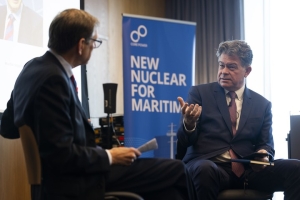


(Posted on 19/06/24)
Over 350 delegates registered for CORE POWER's landmark New Nuclear for Maritime Summit held in London on June 13th. With only standing room left at the back, the event was at capacity as over 40 speakers and panellists from across nuclear and maritime sectors, as well as finance professionals and regulators, powered through a packed program of energy security, decarbonisation, regulations, standards, markets, technology and economics.
“The sheer number of attendees who stayed and engaged in discussion through the whole day is a testament to how important nuclear energy in maritime has become in the climate debate,” said Mikal Bøe, Chairman and CEO of CORE POWER.
Presentations, interventions and debating points were added to the proceedings by key members from maritime market segments including dry bulk, tankers, cruise, containers, ports and ship yards, with experts in nuclear technology, safety and security creating lively discussions on how new nuclear technologies can be integrated in floating structures and ships to provide both energy resilience and zero emissions.
“Nuclear is coming off the naughty-shelf,” said Bøe, adding: “We have finally reached the point where the playing field is levelling out, and all energy sources and technologies are being considered on merit and without prejudice.”
Attendance at the event, the fifth since the first CORE POWER Summit in 2022 was up five-fold, with all delegates taking away important action points to prepare for the introduction of new nuclear in the maritime sector.
“Every maritime industry participant must now consider how to invest in building skills, knowledge and tools to prepare for a new nuclear future energy system. Because there will be no net-zero without nuclear, it is really the end game of our energy transition,” said Bøe.
At the summit it was concluded that the key to successful adaptation of new nuclear for maritime is the introduction of technology solutions that are appropriate for use in a dynamic marine environment. Three key criteria must be met for that to happen, including very small emergency planning areas around machines, passive inherent safety of the system and a long fuel cycle avoiding handling of spent nuclear fuels in ports.
Bøe concluded: “The conditions are set and have been transmitted to both the IMO and IAEA for revision of safety standards for floating nuclear and nuclear ships. We expect to see substantial progress being made by the international community to bring standards up to date in the coming few years for new nuclear in maritime to be commercialised in the 2030s.”
Founded in 2018, CORE POWER is a UK-based innovation company spearheading the development and commercialisation of new nuclear technologies for marine applications. With over 60 key strategic shareholders from the global maritime industry and a fast-growing client base of ship yards, ship operators, trading houses, and energy companies, CORE POWER is a leading provider of marine nuclear energy solutions.
NORDEN has acquired the cargo activities of Taylor Maritime in Southern Africa (previously operated... Read more
Philippos Ioulianou, Managing Director of EmissionLink, has warned the IMO’s decision to delay... Read more
VIKAND has highlighted the need for cultural change in the maritime sector as reports of bullying, harassment... Read more
The maritime industry is experiencing a period of significant transformation, driven by rapidly evolving... Read more
NorthStandard has advised Members of a 5% increase in P&I premiums for the marine insurance year... Read more
Anemoi Marine Technologies, the UK-based leading designer of Rotor Sails for wind-assisted ship propulsion... Read more
Helm Operations has announced that nine electronic record books within Helm CONNECT Logbook have been... Read more
International maritime welfare charity Sailors’ Society has announced a significant expansion... Read more
NORDEN has signed a two-year Contract of Affreightment (COA) with Enviva to transport a significant... Read more
Algoma Central Corporation has reported its results for the three and nine months ended 30 September... Read more